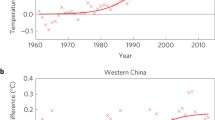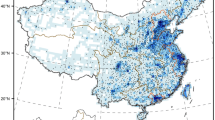Abstract
This paper provides new evidence of regional warming trends from local Chinese observations covering the period 1951–2010. We used satellite-derived land data and weighted urban and rural temperature records (a weighted method) and estimate the regional warming trend, which involves natural climate change and human impact. The annual warming rate over the whole of China is 0.21 ± 0.02 °C/decade. The seasonal warming is 0.30 ± 0.05 °C/decade (Winter), 0.24 °C ± 0.03 °C/decade (Spring); 0.16 ± 0.02 °C/decade (Summer) and 0.21 ± 0.03 °C/decade (Autumn). The mean warming trend is lower than previous estimates (e.g. NMIC, CRU-China) using un-weighted methods (arithmetic average of all records). The warming difference between the weighted and un-weighted accounts for 27 % (12 %) of the NMIC (CRU-China) un-weighted estimate on the total warming. This indicates that previous estimations overestimated a regional warming trend. The differences can be partly attributed to the weighting of the urban effect which is taken into consideration in this study, resulting in a much slower temperature increase. Spatially, the northern part of China shows a larger difference than the south especially for winter and spring. We argue that it is of importance to take into consideration the influence of urban land-use change to improve the physical understanding of surface warming in China over past decades.





Similar content being viewed by others
Explore related subjects
Discover the latest articles and news from researchers in related subjects, suggested using machine learning.Abbreviations
- CAM:
-
Climate Anomaly Method
- CAS:
-
Chinese Academy of Sciences
- CE:
-
Coefficient of Efficiency
- CMA:
-
China Meteorological Administration
- CRU:
-
Climatic Research Unit
- FDM:
-
First Differences Method
- GCPs:
-
Ground Control Points
- GISS:
-
Goddard Institute for Space Studies
- NASA:
-
National Aeronautics and Space Administration
- NMIC:
-
National Meteorological Information Centre
- P-E:
-
Peterson and Easterling
- RE:
-
Reduction of Error
- RSM:
-
Reference Station Method
- SAT:
-
Surface Air Temperature
- SD:
-
Standard Deviations
- SE:
-
Sampling error
- UHI:
-
Urban Heat Island
References
Briffa KR, Jones PD (1993) Global surface air temperature variations over the twentieth century, Part 2: Implications for large-scale paleoclimatic studies of the Holocene. Holocene 3:77–88. doi:10.1177/095968369300300109
Brohan P, Kennedy JJ, Harris I et al (2006) Uncertainty estimates in regional and global observed temperature changes: A new data set from 1850. J Geophys Res 111, D12106. doi:10.1029/2005JD006548
Easterling DR, Peterson TC (1995) A new method for detecting and adjusting for undocumented discontinuities in climatological time series. Int J Climatol 15:369–377. doi:10.1002/joc.3370150403
Folland CK, Rayner NA, Brown SJ et al (2001) Global temperature change and its uncertainties since 1861. Geophys Res Lett 28(13):2621–2624. doi:10.1029/2001GL012877, GL012877
Hansen J, Ruedy R, Sato M et al (2001) A closer look at United States and global surface temperature change. J Geophys Res 106:23947–23963. doi:10.1029/2001JD000354
Hansen J, Ruedy R, Sato M (2010) Global surface temperature change. Rev Geophys 48:RG4004. doi:10.1029/2010RG000345
Harris I, Jones PD, Osborn TJ et al (2013) Updated high-resolution grids of monthly climatic observations–the CRU TS3.10 data set. Int J Climatol, in press
Hausfather Z, Menne MJ, Williams CN et al (2013) Quantifying the effect of urbanization on U.S. historical climatology network temperature records. J Geophys Res. doi:10.1029/2012JD018509, in press
Hua LJ, Ma ZG, Guo WD (2008) The impact of urbanization on air temperature across China. Theor Appl Climatol 93:179–194. doi:10.1007/s00704-007-0339-8
Jones PD (1994) Hemispheric Surface air temperature variations: a reanalysis and an update to 1993. J Clim 7:1794–1802. doi:10.1175/1520-0442(1994)007
Jones PD, Raper SCB, Santer BD et al (1985) A grid point surface air temperature data set for the Northern Hemisphere. Tech. Rep. TR022, 251 pp., Carbon Dioxide Res. Div., U. S. Dep. of Energy, Washington, D. C. (Available at www.cru.uea.ac.uk/st/TR022.pdf.)
Jones PD, Osborn TJ, Briffa KR (1997) Estimating sampling errors in large-scale temperature averages. J Clim 10:2548–2568
Jones PD, Lister DH, Li Q (2008) Urbanization effects in large-scale temperature records, with an emphasis on China. J Geophys Res 113, D16122. doi:10.1029/2008JD009616
Jones PD, Lister DH, Osborn TJ et al (2012) Hemispheric and large-scale land surface air temperature variations: an extensive revision and an update to 2010. J Geophys Res. doi:10.1029/2011JD017139
Li Q, Li W (2007) Development of the gridded historic temperature dataset over China during recent half century. Acta Met Sinica (in Chinese) 65:293–299
Li Q, Zhang H, Liu X et al (2004) Urban heat island effect on annual mean temperature during the last 50 years in China. Theor Appl Climatol 79:165–174. doi:10.1007/s00704-004-0065-4
Li Q, Zhang H, Chen J et al (2009) A mainland China homogenized historical temperature dataset of 1951–2004. Bull Am Meteorol Soc 90:1062–1065. doi:10.1175/2009BAMS2736.1
Liu XD, Chen BD (2000) Climatic warming in the Tibetan Plateau during recent decades. Int J Climat 20:1729–1742. doi:10.1002/1097-0088(20001130)20:14 < 1729::AID-JOC556 > 3.0.CO;2-Y
Liu J, Liu M, Deng X et al (2002) The land use and land cover change database and its relative studies in China. J Geogr Sci 12:275–282
Liu JY, Tian HQ, Liu ML (2005) China’s changing landscape during the 1990s: large-scale land transformations estimated with satellite data. Geophys Res Lett 32, L02405. doi:10.1029/2004GL021649
Meko DM, Graybill DA (1995) Tree-ring reconstruction of Upper Gila River discharge. Water Resources Bulletin 31:605–616
Peterson TC, Easterling DR (1994) Creation of homogeneous composite climatological references series. Int J Climat 14:671–679. doi:10.1002/joc.3370140606
Peterson TC, Owen TW (2005) Urban heat island assessment: metadata are important. J Clim 18:2637–2646
Peterson TC, Karl TR, Jamason PF et al (1998) The first difference method: Maximizing station density for the calculation of long-term global temperature change. J Geophys Res 103:25967–25974
Quayle RG, Peterson TC, Basist AN et al (1999) An operational near-real-time global temperature index. Geophys Res Lett 26:333–335. doi:10.1029/1998GL900297
Ren YY, Ren GY (2011) A remote-sensing method of selecting reference stations for evaluating urbanization effect on surface air temperature trends. J Clim 24(7):3179–3189. doi:10.1175/2010JCLI3658.1
Ren GY, Zhou YQ, Chu ZY et al (2008) Urbanization effect on observed surface air temperature trend in North China. J Clim 21:1333–1348. doi:10.1175/2007JCLI1348.1
Smith TM, Ropelewski CF, Reynolds RW (1994) Optimal averaging of seasonal sea surface temperatures and associated confidence intervals (1860–1989). J Climate 7:949–964. doi:10.1175/1520-0442(1994)007 < 0949:OAOSSS > 2.0.CO;2
Smith TM, Reynolds RW, Peterson TC et al (2008) Improvements to NOAA’s historical merged land-ocean surface temperature analysis (1880–2006). J Clim 21:2283–2293. doi:10.1175/2007JCLI2100.1
Tang GL, Ding YH (2007) Impacts of the average air temperature derived from maximum and minimum temperatures on annual mean air temperatures series of China. J Appl Meteorol 2:187–192
Vogelmann JE, Helder D, Morfitt R et al (2001) Effects of Landsat 5 Thematic Mapper and Landsat 7 Enhanced Thematic Mapper Plus radiometric and geometric calibrations and corrections on landscape characterization. Remote Sens Environ 78:55–70. doi:10.1016/S0034-4257(01)00249-8
Wang F, Ge QS (2012) Estimation of urbanization bias in observed surface temperature change in China from 1980 to 2009 using satellite land-use data. Chin Sci Bull 57(14):1708–1715. doi:10.1007/s11434-012-4999-0
Wang WC, Zeng Z, Karl TR (1990) Urban heat islands in China. Geophys Res Lett 17:2377–2380. doi:10.1029/GL017i013p02377
Yang XC, Hou YL, Chen BD (2011) Observed surface warming induced by urbanization in east China. J Geophys Res 116, D14113. doi:10.1029/2010JD015452
Yao TD, Guo XJ, Thompson LG et al (2006) δ18O record and temperature change over the past 100 years in ice cores on the Tibetan Plateau. Science in China (Ser. D) 49(1):1–9. doi:10.1007/s11430-004-5096-2
Zhang XG, Li XQ (1982) Some characteristics of temperature variation in China in the present century. Acta Met Sinica 2:198–208
Zhang AY, Ren GY, Zhou JX et al (2010) Urbanization effect on surface air temperature trends over China. Acta Meteorologica Sinica(in Chinese) 68(6):957–966
Zheng JY, Yin YH, Li BY (2010) A new scheme for climate regionalization in China. Acta Geographica Sinica 1:3–12
Zhou LM, Tucker CJ, Kaufmann RK et al (2001) Variations in northern vegetation activity inferred from satellite data of vegetation index during 1981 to 1999. J Geophys Res 106:20069–20083. doi:10.1029/2000JD000115
Acknowledgments
The authors thank Profs. Wang Shaowu, Li Qinxiang, Xu Xinliang and Dr. Zhang Xuezheng for their valuable comments and data support. This work was supported by the MOST project of China (2010CB950101), the National Natural Science Foundation of China (41101083), the Chinese Academy of Sciences project (XDA05080100), the DFG Projects AFICHE (“Attribution of forced and internal Chinese climate variability in the common era”) and PRIME 2 (“Precipitation In past Millennia in Europe- extension back to Roman times”,) within the Priority Programme “INTERDYNAMIK”.
Author information
Authors and Affiliations
Corresponding author
Additional information
This work was supported by the MOST project of China (2010CB950101), the National Natural Science Foundation of China (41101083), the Chinese Academy of Sciences project (XDA05080100), the DFG Projects AFICHE (“Attribution of forced and internal Chinese climate variability in the common era”) and PRIME 2 (“Precipitation In past Millennia in Europe- extension back to Roman times”) within the Priority Programme “INTERDYNAMIK”.
Electronic supplementary material
Supplementary Information accompanies the paper on www.editorialmanager.com/clim/
ESM 1
(DOC 900 kb)
Rights and permissions
About this article
Cite this article
Ge, Q., Wang, F. & Luterbacher, J. Improved estimation of average warming trend of China from 1951–2010 based on satellite observed land-use data. Climatic Change 121, 365–379 (2013). https://doi.org/10.1007/s10584-013-0867-4
Received:
Accepted:
Published:
Issue Date:
DOI: https://doi.org/10.1007/s10584-013-0867-4




